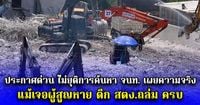The recent building collapse in Lat Krabang has left the Bangkok Metropolitan Administration (BMA) grappling with the aftermath as they work diligently to provide compensation and clarity to the victims and their families. The tragic event, which has claimed numerous lives and left many injured, has prompted a thorough investigation involving forensic experts and structural engineers.
As of May 4, 2025, the BMA has confirmed a total of 109 victims associated with the collapse, with 86 individuals being identified as deceased. Among the deceased, 63 are Thai nationals, 15 are Burmese, and one each from Cambodia and Laos. Additionally, 9 individuals were reported injured, while 14 remain unaccounted for. This grim tally reflects the urgent need for clarity and support for the affected families.
Mr. Suriyachai Raviwan, Deputy Permanent Secretary of the BMA, emphasized that the administration is committed to ensuring that no victim is overlooked in the compensation process. "Those who are not at fault should not worry," he stated, assuring that the BMA is taking all necessary steps to expedite compensation payments. This initiative aims not only to provide financial relief but also to bring closure to the grieving families.
In an effort to gather more information about the cause of the collapse, forensic teams have been collecting evidence from the site. They are specifically examining debris from the precast support columns, which measure 7.5 cm in diameter and 20-30 cm in height. These samples will be tested to determine their ultimate strength, as any structural failure could have serious implications for accountability and future safety regulations.
On the investigation front, the Department of Special Investigation (DSI) has opened 121 cases related to the collapse, questioning eight individuals, including Mr. Samchai, a structural engineer involved in the project. Mr. Samchai has admitted to making construction errors, stating that the adjustments made to the lift shaft and shear wall were procedural, though he did not intend for them to compromise safety. "I know about the additional construction errors, including nine issues related to the lift shaft and shear wall," he confessed, indicating a willingness to accept responsibility for the mistakes.
The BMA's efforts to improve the situation have led to the complete opening of Zone D at the collapse site, while Zones B and C are still undergoing checks for vehicle access. These areas are critical as they may harbor individuals who were trapped during the incident. Rescue teams are working tirelessly to ensure that every possible avenue is explored to locate any remaining victims.
As the search continues, the BMA has reiterated its commitment to not halt operations until they are confident that no one is left behind in the rubble. The urgency of this mission is underscored by the discovery of signs of life, such as fluid traces and insects, which suggest that there may still be individuals trapped beneath the debris.
Challenges persist, however, as the structural integrity of the remaining building poses significant risks to rescue teams. Heavy machinery is being deployed to cut through the robust steel framework, allowing access to previously unreachable areas. Currently, six machines are actively engaged in this effort, and if successful, they will have cleared more than half of the underground areas of the building.
The BMA's proactive measures include not only the immediate rescue and compensation efforts but also a broader commitment to reviewing safety regulations and construction practices to prevent such tragedies in the future. The administration is keenly aware that the emotional and psychological toll on the victims' families is profound, and they are striving to address this as part of their comprehensive response.
In light of the ongoing investigation, it is crucial for all involved parties to cooperate fully to ensure that accountability is established. The BMA's assurance that compensation will be handled with care and urgency is a step in the right direction, but it also raises questions about the adequacy of current building regulations and the oversight mechanisms in place.
The Lat Krabang building collapse serves as a stark reminder of the fragility of human life in the face of structural failures. As the community mourns the loss of life and grapples with the repercussions of this disaster, the hope is that through thorough investigation and reform, such incidents can be prevented in the future.
As the rescue operations continue and the investigations unfold, the BMA remains resolute in its mission to provide support and justice for those affected by this tragic event. The path forward will require collaboration, transparency, and a steadfast commitment to ensuring safety in construction practices across Bangkok and beyond.




